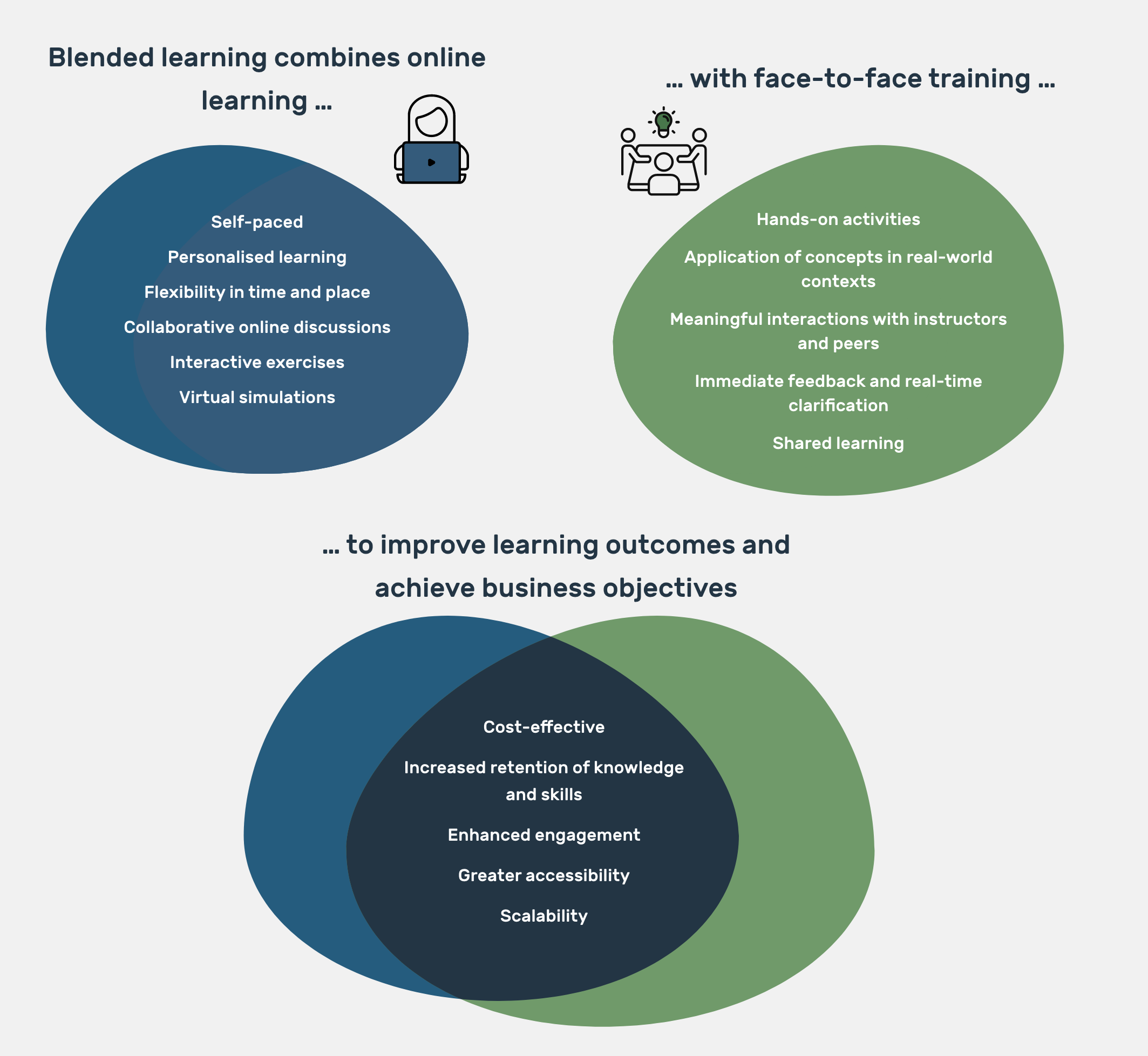Blended Learning for Adult Education: Combining the Best of Both Worlds
In recent years, the field of education has witnessed a significant shift towards blended learning, a powerful approach that combines traditional face-to-face instruction with online learning components (Garrison & Kanuka, 2004). Blended learning has gained popularity across various educational levels, and it has proven to be particularly effective in adult education. This article explores the benefits of blended learning for adult learners, including increased flexibility, personalisation, improved learning outcomes, and the importance of instructional design in its implementation.
One of the key advantages of blended learning in adult education is the enhanced flexibility it offers. Adult learners often have busy schedules, juggling work, family, and other commitments. Blended learning allows them to have greater control over their learning experience by providing the flexibility to access course materials and participate in activities at their own pace and convenience. The online components of blended learning, such as prerecorded lectures or interactive modules, can be accessed anytime and anywhere, enabling adult learners to fit their studies into their busy lives (Wainhouse Research, 2021).
Moreover, blended learning provides adult learners with personalised learning experiences that cater to their unique needs and preferences. Adult learners come from diverse backgrounds and possess varying levels of prior knowledge and skills. Blended learning allows instructional designers to tailor the learning experience to meet the specific needs of each learner (Singh, 2003). Online assessments and adaptive learning technologies can be used to gauge learners’ knowledge and provide targeted feedback and resources. Additionally, adult learners can engage in collaborative online discussions, virtual simulations, or interactive exercises, which cater to different learning styles and preferences, fostering a more personalised and engaging learning experience (Rovai & Jordan, 2004).
Furthermore, blended learning has been shown to improve learning outcomes in adult education. Research suggests that the integration of online and face-to-face instruction leads to better retention of knowledge and skills (Means et al., 2010). The online components of blended learning provide learners with opportunities for self-paced learning, repetition, and reinforcement. Meanwhile, face-to-face sessions allow for meaningful interactions with instructors and peers, promoting deeper understanding and application of concepts. The combination of these two modalities facilitates a comprehensive and holistic learning experience, resulting in improved learning outcomes for adult learners (Brown & Bryan, 2015).
To effectively implement blended learning in adult education, careful instructional design is essential. Instructional designers play a crucial role in creating a cohesive and seamless learning experience that integrates online and face-to-face components (Garrison & Kanuka, 2004). They must carefully select and design the online materials, ensuring they align with the learning objectives and provide engaging and interactive content. Moreover, instructional designers need to design face-to-face sessions that complement and build upon the online components, fostering meaningful interactions and discussions (Williams, 2022).
Blended learning offers a range of instructional strategies that can be leveraged to enhance adult learning experiences. Asynchronous online activities, such as discussion forums or self-paced modules, provide flexibility and allow learners to engage with course content at their convenience (Murphy & Rodríguez-Manzanares, 2009). Synchronous sessions, on the other hand, enable real-time interactions through video conferences or live webinars, promoting active engagement and collaboration (Khechine & Lytras, 2018). By combining these approaches, blended learning creates a dynamic and interactive learning environment that addresses the unique needs and preferences of adult learners.
In addition to its benefits for learners, blended learning also offers advantages for instructors. It allows instructors to leverage technology to deliver content, provide feedback, and assess learning outcomes more efficiently (Cavanaugh, 2005). Online tools and platforms enable instructors to track learners’ progress, identify areas of improvement, and provide timely support and guidance. Moreover, blended learning provides opportunities for instructors to experiment with innovative teaching methods, incorporating multimedia resources, gamification elements, and social learning activities (Smith, 2020). This dynamic teaching environment fosters instructor creativity and enhances the overall learning experience.
In conclusion, blended learning has emerged as a powerful approach in adult education, providing numerous benefits for learners. Its flexibility allows adult learners to balance their educational pursuits with their other responsibilities. The personalisation aspect of blended learning caters to the diverse needs and preferences of adult learners, enhancing their engagement and motivation. Additionally, blended learning’s integration of online and face-to-face instruction leads to improved learning outcomes. As adult education continues to evolve, instructional designers must harness the potential of blended learning and carefully design learning experiences that leverage its benefits (Garrison & Kanuka, 2004).
References:
Brown, G. T., & Bryan, M. A. (2015). Learning in an Online Distance Education Program: Examining Satisfaction and Community. The Internet and Higher Education, 25, 70-77.
Cavanaugh, C. (2005). Teaching Online – A Time Comparison. Online Journal of Distance Learning Administration, 8(1).
Garrison, D. R., & Kanuka, H. (2004). Blended learning: Uncovering its transformative potential in higher education. The Internet and Higher Education, 7(2), 95-105.
Khechine, H., & Lytras, M. D. (2018). A Comprehensive Study on Blended Learning in Education. Journal of Educational Technology & Society, 21(2), 222-236.
Means, B., Toyama, Y., Murphy, R., Bakia, M., & Jones, K. (2010). Evaluation of evidence-based practices in online learning: A meta-analysis and review of online learning studies. US Department of Education.
Murphy, E., & Rodríguez-Manzanares, M. A. (2009). Asynchronous and Synchronous Online Teaching: Perspectives of Canadian High School Distance Education Teachers. British Journal of Educational Technology, 40(3), 433-448.
Rovai, A. P., & Jordan, H. M. (2004). Blended Learning and Sense of Community: A Comparative Analysis with Traditional and Fully Online Graduate Courses. International Review of Research in Open and Distributed Learning, 5(2), 1-13.
Singh, H. (2003). Building effective blended learning programs. Educational Technology, 43(6), 51-54.
Smith, A. (2020). The Benefits of Blended Learning: A Report from the Education Research Center. Retrieved from https://www.coursera.org/research/erp/blended-learning
Wainhouse Research. (2021). Blended Learning: Best Practices, Benefits, and Tips for Success. Retrieved from https://www.wainhouse.com/files/docs/research-notes/Wainhouse-Research-Blended-Learning-Best-Practices.pdf
Williams, R. (2022). Designing Effective Blended Learning Environments for Adult Learners. Adult Learning, 34(3), 122-128.

